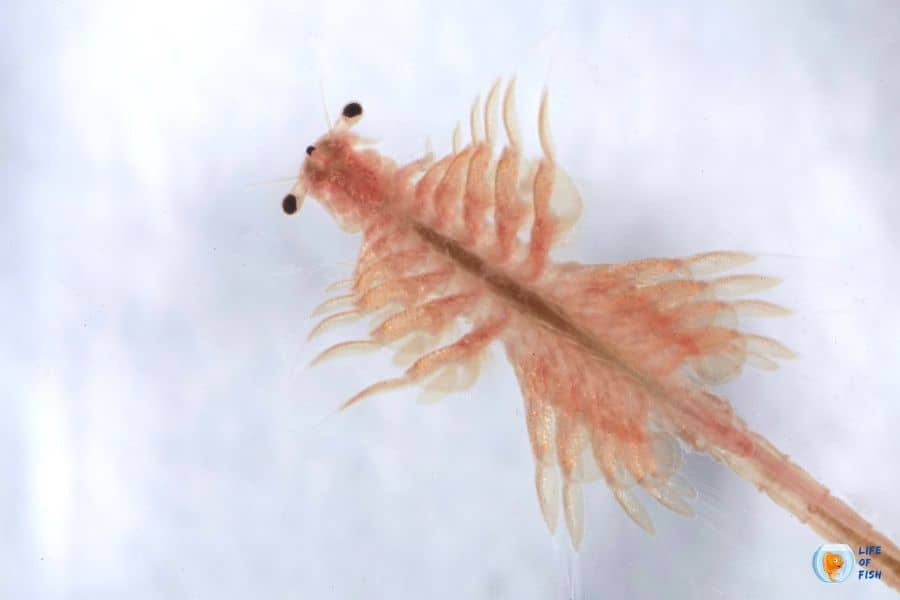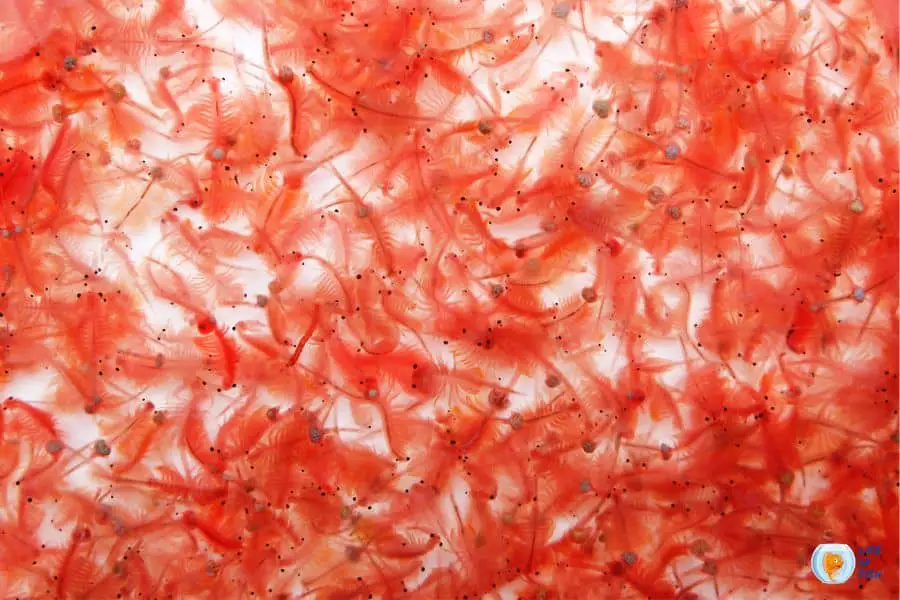If you are thinking about installing brine shrimp in your fish and aquarium, here’s how to keep brine shrimp alive. Brine shrimp are crustaceans that live in saltwater. They are excellent for cleaning up after other fish. The more often you clean your tank, the more likely it will be that you will end up having brine shrimp in there.

Although there is a variety of new and specialized fish food products available, fish owners are still encouraged to feed their fish with brine shrimp. Further, no artificial feed formulation is yet available to completely substitute for brine shrimp.
Therefore feeding live prey to young fish and crustacean larvae remains essential in commercial hatchery operations. The nutritional properties of newly hatched brine shrimp are high in lipids and unsaturated fatty acids. Though you can buy readily available live brine shrimp from the market, even you can raise them at home if you know a little about how they live.
Getting started
Jump To
You need at least 10 gallons of the glass tank. Apart from the tank, you need the following apparatus to set up the tank.
- Lighting unit
- Sand substrate
- Sponge filter
- Air stone/bubbler
- Heater
- Water conditioner
Then set up the tank as follows.
- Brine shrimps prefer sandy substrate. Before adding sand to the tank rinse the sand with running water to remove dust that would otherwise cloud your water.
- Then add a thin layer of sand to cover the bottom of the aquarium. You can add a few decorations too.
- Take the help of a plate or upside-down dish to avoid the sand scattered all over the place when you pour the water into the tank.
- Install the heater and the filter in the tank
- Fill the tank with dechlorinated tap water. Slowly, pour the water over the upturned plate to avoid sand scattering.
- Before you add the shrimp, you have to cycle the water in the tank. For that, the water should contain a small amount of ammonia to kick off the cycle. You can add some fish feed into the water or add a few drops of pure ammonia
- Then activate the sponge filter and the heater
- Leave the tank to cycle for ten days and test the water from time to time (on alternate days)
- Wait until the levels of ammonia and nitrite are at zero. At this time nitrate level should be 20 ppm or less.
- Now your tank is ready to raise brine shrimps !!

Water condition (temperature and quality)
Brine shrimp prefer salt water. They live in salt concentrations with a specific gravity range of 1.011 to 1.028. You can either use reverse osmosis water or clean unchlorinated water to fill the tank. To make your aquarium water salty, you can add aquarium salt or marine salt. However, make sure to keep the right degree of salinity. You can do this simply, by using a hydrometer. Based on the readings of the hydrometer you can either add water or add more salt.
This can be done at the rate of one tablespoon for one cup of water. You should keep the ultimate salinity between 30-35 ppt. The optimal temperature conditions for brine shrimp range from about 77 to 86 degrees Fahrenheit. However, it can be varied slightly, depending on the strain that is cultured. The ammonia and nitrite concentrations should be zero while the nitrate level should be lower than 20 ppm.
Asides from the factors mentioned above, the pH of the water is also important for the healthy grow up of brine shrimps. The water should be maintained in the pH range of 8-9. Experiments show that they do well in an alkaline environment.
Amount of light
Usually, brine shrimps like light and are attracted to light. Especially, newly-hatched brine shrimp, or nauplii, are strongly attracted to white light or sunlight. Adult brine shrimp may show different behaviors than the nauplii and may be either attracted to white light or sunlight or repelled by it. If you put a bright light near the aquarium, you can see they gather near the light source.
According to the experts, they spend much of their energy in an effort to remain near the light source. This will affect their health condition negatively and lowers their quality as a feed to other fish. Therefore, it is better to keep a light source with a low light level if you need to install a light source for them. Probably, A 60- to 100-watt light will suffice for them under normal conditions. During the hatching, you need a higher light level (2000 lux constant illumination)
Circulation
Strong aeration and good water circulation are essential to growing healthy adult brine shrimp. You can use either air stones or an air pump to keep good aeration. You will need to come up with a way to rig your pump. Because that setup assure the water is continually circulating through all regions of the tank.
If you use airstones, use only those that make large bubbles. Brine brine shrimp will ingest small air bubbles (or they lodge in their swim appendages), which forces them to the surface where they will eventually die. Further, the small water bubbles lodge in their swim appendages which makes them trouble to move.
Food
Being the filter feeders, brine shrimps heavily feast on particles in the water column as well as inert nutrients. You can feed your brine shrimp with egg yolk, whey, soybean powder, or wheat flour. Newly-available enrichment formulas such as Selcon are highly recommended if you are keeping the hatchery at the commercial level. Further, you can feed them with dried algae such as spirulina.
Whatever, the food you are feeding them, keep in mind not to overload the tank with inert foods. It leads to fouling the water and the ultimate result is low oxygen levels. Further, since the foods you provide are small in size, it leads to foul the water even faster. Most of the aquarists recommended feeding them twice a day with a sufficient amount of food. However, small amounts several times a day also work.
You don’t need to provide food from outside for the newly hatched brine shrimp for 24 hours. During their first 24 hours of life, the rich egg yolk of brine shrimp sustains them.

How long will brine shrimp stay alive?
It is very important to keep the harvested brine shrimp alive. You can simply harvest the brine shrimp into a fine mesh net and rinse them with fresh water. Then put them in salt water with the correct concentration and refrigerate the container. The refrigeration slows their metabolism to where they’re near death but revives when they hit the warm water in the tank. You can keep alive them for 48 hours for later feedings in this way.
Can brine shrimp live without an air pump?
Yes, they can live even without an air pump. According to the experts, they can live up to 2-3 days in an open container. Even you can technically hatch brine shrimp without an air pump. The duty of the air pump or air stone is to be constantly suspended the eggs in the water column and supply the oxygen for the eggs to hatch. You can fulfill those requirements with, a few specific tools or pieces of equipment instead of an air pump.
Do you need a heater for brine shrimp?
Although brine shrimp are highly adaptable to environmental fluctuations such as temperature, they grow well in temperatures between 80-82°F (26-28°C). Brine shrimp are cold-blooded so their metabolism slows down when the water is cold and speeds up when the water is warm.
Therefore, if your aquarium is located in a cold area install a heater. A heat lamp is an easy way to do this. More on, the temperature is a crucial parameter in hatching eggs. Lower temperatures than 26°C will result in a longer hatching time and inefficient hatches. However, make sure the temperature will not exceed 86° (30°C).
Do brine shrimp need salt water?
Brine is in the shrimp’s name because of the salty water habitat they grow in. the best range is salt concentration with a specific gravity range of 1.011 to 1.028.
Can frozen brine shrimp come back to life?
No, there is no way to become live after frozen.
Can brine shrimp be pets?
Although they are not looking fancy, you can still raise them as pets. Brine shrimp are very active little creatures that spend their time busily filtering food from the water and breeding. However, if you have an idea to raise them as pets, you need to have a separate tank for them. They cannot be raised with any fish or invertebrate due to following reasons.
- Brine shrimp need very clean water to thrive and they need a spacious tank. If you keep your brine shrimp in a small 1-gallon setup, there won’t be enough space to accommodate anything else without upsetting the ecology of the tank.
- Most omnivorous fish and inverts will eat the brine shrimp!
You can simply, decorate the tank by including a sandy substrate and a few rocks as decoration.

Maintenance
You should carry out routine maintenance on your brine shrimp tank to keep the environment healthy and clean. Changing 25% of saltwater each month is important. During this process, you can use an aquarium vacuum to remove dead shrimp and cysts from the tank bottom. However, it is advised to get a helper to shine a flashlight into the tank to lure the shrimp away from the vacuum so that you don’t end up accidentally sucking up your shrimp.
You may need to add water to the tank to top up the levels because of evaporation. Do not use salt water as it will increase the salinity within the tank and unbalance the environment. Use the hydrometer to check the specific gravity levels in the tank when adding water to the aquarium.
Final thoughts
It definitely is not easy to keep brine shrimp alive for a very long time. Like many live foods, brine shrimp have a very short life expectancy. However, there are some techniques you can use to keep them alive. Now you are familiar with the tips on How to keep brine shrimp alive?. In summary, brine shrimp are a very popular choice for freshwater aquariums because of their size, compatibility with saltwater and cost-effectiveness. In most cases, they can be kept alive with a little effort put into their care.
Read Next : Is Super Glue Aquarium Safe? (And Correct Way To Use)
